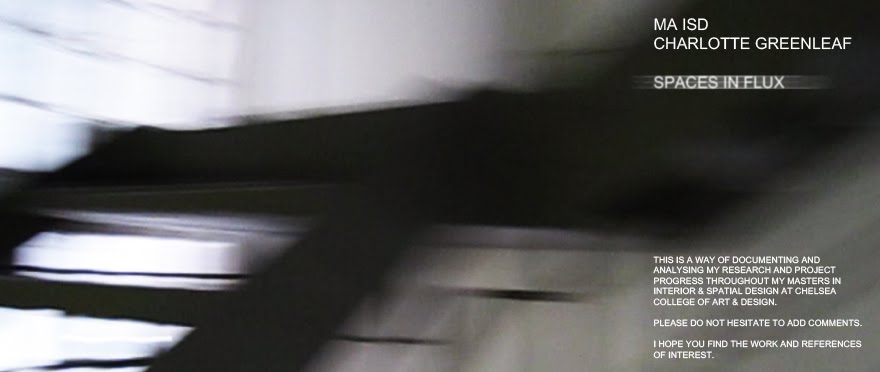
Thursday, 28 January 2010
Spiral

Wednesday, 27 January 2010
Graham Ellard & Stephen Johnstone



I have found this work extremely outstanding for its approach to the relationship between architecture and film. Particularly of relevance at this stage of my project due to the use of devices to film architectural spaces. Devices which truly interact with the architectural spaces and which are derived from the particularity of the architectural spaces in order to give an insight into the motion path of these spaces.
Tacita Dean


Tuesday, 26 January 2010
Catherine Yass
Since 2002, Yass has been increasingly making films along side her photographic projects. These films explore the psychological impression of architectural space. Descent is a film she made by lowering a camera by crane to the ground over a construction site, down the side of a high-rise office block in Canary Wharf, through thick fog. The resulting film was then screened in reverse, and displayed along side a number of upturned images. As a result of the camera being lowered through thick fog, the surrounding buildings are revealed in slow motion, abstracted into streaks of colour, where ascent is exchanged for descent and speed for disorientating slowness.

Still from Descent 2002, Image from Tate online

Descent, Ilfochrome transparency, lightbox, Image from Alison Jacques Gallery website
The following article in Frieze Magazine gives a particularly insightful description of Catherine Yass's work. Relating and comparing it to the 1960s, when film artists would make an aspect of their apparatus the subject, revealing their working process.
Yass's work is particularly of relevance for the use of a device to film and abstract environments. She subsequently went on to film Flight which was filmed from a remote control helicopter flying around the roof of Broadcasting House in London.
Brainstorming & Tutorial Discussion
Concerns
- Transience in today’s culture - Every day, the average human fluxes through a series of juxtaposing internal and external spaces which reveal and obscure themselves to us as we journey from one destination to another. In viewing spaces in a state of motion, we immerse ourselves in a continuous movement of shifting orientations and crossed viewpoints, where our perceptions of space change as we progress.
- Travel – gradual transition from one environment to another
- I am concerned with the participation of the viewer within spaces, whereby through experiencing spaces in a state of flux, the juxtaposition of movement and stillness results in activating and revealing the space.
- I am concerned with a visual interplay with the way we see space so that the viewer’s positioning has a direct effect on how space is seen. This relates to an interest in the ability to change and obscure a space’s visual identity and transform our attention to surrounding environments. Environments which appear to be moving, but in reality are not - Creating a visually dynamic environment.
- Physically kinesthetic form of design and modelling of space
- Architectural journey – Spatial interactive experience between body and space
- Trajectories – path of a moving object through space
- Architecture that involves an unfolding experience as the viewer moves through it – sequential experience - associated with the cinematic concept of architectural montage, artificially created continuous spaces.
- The virtual transient exploration and manipulation of space in cinema, in relation to the visual experiential sequencing of space in architecture and installation art.
- My inquiry concerns movement and its relation to spatial manipulation.
- How we visually comprehend space through movement and how we can design to enhance the average experience of moving through a space.
- As a means of controlling the camera movement (dollies)
- Moving in two directions, roller coaster mechanism
- Maybe the camera records the mechanism
- Where is the spatial manipulation done? Unedited film - could enable me to avoid editing by computer software
- Complex mechanisms
- Using the twist / spiral - which has been concurrent through a lot of my work - compound movements - more than in one direction
- The device as a process to the next step
- Looking for buildings which have twisting movement qualities - but also devise a mechanism which allows me to film other spaces
- How the movement might really start to engage the space
- What it reveals when it twists
- Film the device - relationship between the device and the image
- How I show the films - a mechanism/monitor that moves
Thursday, 21 January 2010
Joe King Lecture, University of Westminster

Monday, 18 January 2010
Decode, Victoria & Albert Museum, visited 18 Jan 2010



Weave Mirror involves a screen of motorized C-shaped elements which rotate, tracing the movements of the viewer. Subsequently a blurred smoky rustic image is produced of the character in front of the installation. The electronics and wiring of the artwork is left exposed on the back of the screen to show the complexity of the movement instilled in this piece.

